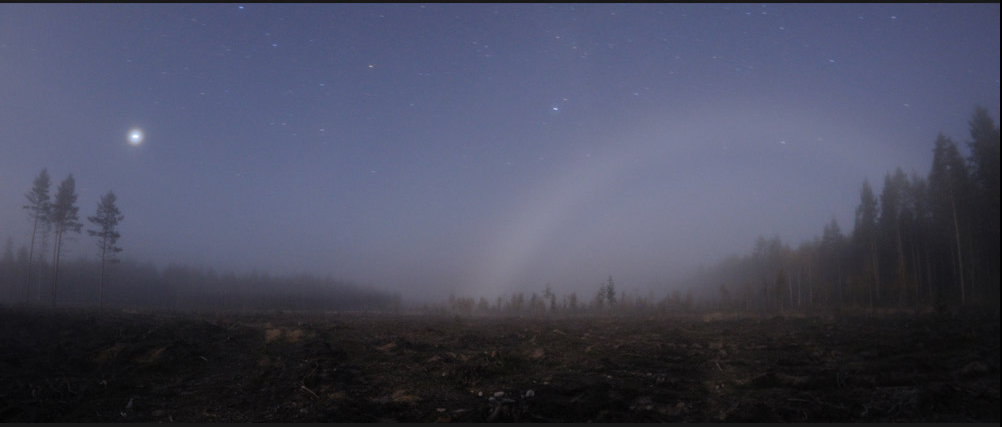OPOD - Lunar Fogbow & Jupiter Aureole
OPOD - Lunar Fogbow & Jupiter Aureole: A Captivating Atmospheric Phenomenon
Have you ever gazed up at the night sky and been mesmerized by the enchanting interplay of light and mist? Nature has a way of captivating us with its awe-inspiring atmospheric optics, and one such phenomenon is the ethereal combination of a lunar fogbow and a Jupiter aureole. Let's delve deeper into this captivating spectacle and explore the science behind it.
The Enigmatic Lunar Fogbow
As the waning half moon casts its gentle glow upon the Earth, a delicate mist hangs in the air, creating the perfect conditions for the formation of a lunar fogbow. Similar to a traditional rainbow, a fogbow is formed when sunlight interacts with tiny water droplets suspended in the mist. However, unlike a rainbow, which is created by refraction, a fogbow is formed through diffraction.
Unraveling the Mystery of Diffraction
When light encounters an obstacle or passes through a narrow opening, it diffracts or spreads out. In the case of a fogbow, the mist droplets act as tiny obstacles, causing the light to diffract. As a result, instead of the vibrant colors we associate with rainbows, a fogbow appears as a faint, colorless arc. The waning half moon's light is still sufficiently bright to illuminate these mist droplets, creating an ethereal glow.
Embracing the Jupiter Aureole
But the enchantment does not end there. In this captivating display of atmospheric optics, the same mist droplets that form the lunar fogbow also diffract light from Jupiter, forming a surrounding aureole. An aureole is a halo-like phenomenon that occurs when light is scattered or diffracted by particles in the atmosphere. In this case, the mist droplets serve as the scattering medium, transforming Jupiter's light into a mesmerizing celestial halo.
The Dance of Light and Mist
The dance of light and mist that gives rise to the lunar fogbow and Jupiter aureole is a delicate interplay between diffraction, illumination, and atmospheric conditions. It is a reminder of the intricate beauty that exists within our natural world, inviting us to pause and appreciate the wonders that surround us.
Capturing the Magic: Jonas Förste's Remarkable Image
On the 29th of September, photographer Jonas Förste had the privilege of capturing this enchanting phenomenon in Finland. His wide-angle image beautifully showcases the ethereal lunar fogbow encircling the moon, while the Jupiter aureole adds an extra touch of celestial magic. It serves as a testament to the photographer's skill and the power of nature to inspire awe and wonder.
Exploring Atmospheric Optics: A Window into Nature's Artistry
The occurrence of a lunar fogbow and Jupiter aureole is just one example of the captivating atmospheric optics that grace our skies. From rainbows and halos to sundogs and mirages, nature constantly astounds us with its artistic prowess. By studying these phenomena, scientists gain valuable insights into the behavior of light, the properties of particles in the atmosphere, and the intricate workings of our planet's natural systems.
Appreciating the Subtle Beauty
Next time you find yourself gazing up at the night sky, take a moment to appreciate the subtle beauty that lies within the interplay of light and mist. Whether it be a lunar fogbow, a Jupiter aureole, or another atmospheric phenomenon, these captivating displays remind us of the incredible complexity and wonder of our natural world.
Conclusion
The enchanting combination of a lunar fogbow and Jupiter aureole showcases nature's ability to create captivating displays through the interplay of light and mist. These ethereal phenomena serve as a reminder of the intricate beauty that exists within our natural world. So, the next time you find yourself under a starry sky, take a moment to embrace the subtle wonders that surround us and appreciate the artistry of atmospheric optics.

Lunar Fogbow & Jupiter Aureole
A wide angle image captured by Jonas Förste in Finland on 29th September. ©Jonas F�rste, shown with permission
The light of the waning almost half moon was still bright enough to form a fogbow from the thin mist. The same mist droplets diffracted light from Jupiter to form a surrounding aureole.
Note: this article has been automatically converted from the old site and may not appear as intended. You can find the original article here.
Reference Atmospheric Optics
If you use any of the definitions, information, or data presented on Atmospheric Optics, please copy the link or reference below to properly credit us as the reference source. Thank you!
-
<a href="https://atoptics.co.uk/blog/opod-lunar-fogbow-jupiter-aureole/">OPOD - Lunar Fogbow & Jupiter Aureole</a>
-
"OPOD - Lunar Fogbow & Jupiter Aureole". Atmospheric Optics. Accessed on April 16, 2024. https://atoptics.co.uk/blog/opod-lunar-fogbow-jupiter-aureole/.
-
"OPOD - Lunar Fogbow & Jupiter Aureole". Atmospheric Optics, https://atoptics.co.uk/blog/opod-lunar-fogbow-jupiter-aureole/. Accessed 16 April, 2024
-
OPOD - Lunar Fogbow & Jupiter Aureole. Atmospheric Optics. Retrieved from https://atoptics.co.uk/blog/opod-lunar-fogbow-jupiter-aureole/.